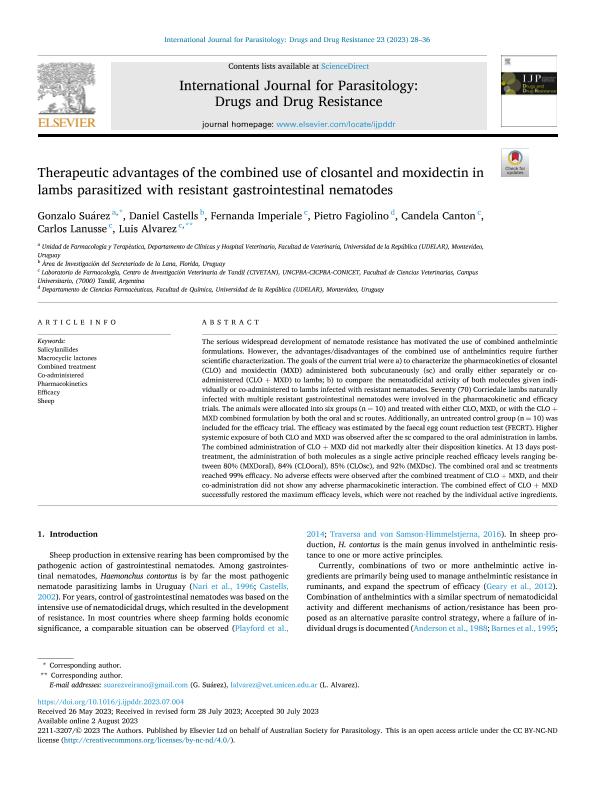Mostrar el registro sencillo del ítem
dc.contributor.author
Suárez, Gonzalo
dc.contributor.author
Castells, Daniel
dc.contributor.author
Imperiale, Fernanda Andrea

dc.contributor.author
Fagiolino, Pietro
dc.contributor.author
Cantón, Candela

dc.contributor.author
Lanusse, Carlos Edmundo

dc.contributor.author
Alvarez, Luis Ignacio

dc.date.available
2024-01-31T17:53:42Z
dc.date.issued
2023-12
dc.identifier.citation
Suárez, Gonzalo; Castells, Daniel; Imperiale, Fernanda Andrea; Fagiolino, Pietro; Cantón, Candela; et al.; Therapeutic advantages of the combined use of closantel and moxidectin in lambs parasitized with resistant gastrointestinal nematodes; Elsevier; International Journal for Parasitology: Drugs and Drug Resistance; 23; 12-2023; 28-36
dc.identifier.issn
2211-3207
dc.identifier.uri
http://hdl.handle.net/11336/225393
dc.description.abstract
The serious widespread development of nematode resistance has motivated the use of combined anthelmintic formulations. However, the advantages/disadvantages of the combined use of anthelmintics require further scientific characterization. The goals of the current trial were a) to characterize the pharmacokinetics of closantel (CLO) and moxidectin (MXD) administered both subcutaneously (sc) and orally either separately or co-administered (CLO + MXD) to lambs; b) to compare the nematodicidal activity of both molecules given individually or co-administered to lambs infected with resistant nematodes. Seventy (70) Corriedale lambs naturally infected with multiple resistant gastrointestinal nematodes were involved in the pharmacokinetic and efficacy trials. The animals were allocated into six groups (n = 10) and treated with either CLO, MXD, or with the CLO + MXD combined formulation by both the oral and sc routes. Additionally, an untreated control group (n = 10) was included for the efficacy trial. The efficacy was estimated by the faecal egg count reduction test (FECRT). Higher systemic exposure of both CLO and MXD was observed after the sc compared to the oral administration in lambs. The combined administration of CLO + MXD did not markedly alter their disposition kinetics. At 13 days post-treatment, the administration of both molecules as a single active principle reached efficacy levels ranging between 80% (MXDoral), 84% (CLOoral), 85% (CLOsc), and 92% (MXDsc). The combined oral and sc treatments reached 99% efficacy. No adverse effects were observed after the combined treatment of CLO + MXD, and their co-administration did not show any adverse pharmacokinetic interaction. The combined effect of CLO + MXD successfully restored the maximum efficacy levels, which were not reached by the individual active ingredients.
dc.format
application/pdf
dc.language.iso
eng
dc.publisher
Elsevier

dc.rights
info:eu-repo/semantics/openAccess
dc.rights.uri
https://creativecommons.org/licenses/by-nc-nd/2.5/ar/
dc.subject
CO-ADMINISTERED
dc.subject
COMBINED TREATMENT
dc.subject
EFFICACY
dc.subject
MACROCYCLIC LACTONES
dc.subject
PHARMACOKINETICS
dc.subject
SALICYLANILIDES
dc.subject
SHEEP
dc.subject.classification
Ciencias Veterinarias

dc.subject.classification
Ciencias Veterinarias

dc.subject.classification
CIENCIAS AGRÍCOLAS

dc.title
Therapeutic advantages of the combined use of closantel and moxidectin in lambs parasitized with resistant gastrointestinal nematodes
dc.type
info:eu-repo/semantics/article
dc.type
info:ar-repo/semantics/artículo
dc.type
info:eu-repo/semantics/publishedVersion
dc.date.updated
2024-01-30T15:44:07Z
dc.journal.volume
23
dc.journal.pagination
28-36
dc.journal.pais
Países Bajos

dc.journal.ciudad
Amsterdam
dc.description.fil
Fil: Suárez, Gonzalo. Universidad de la Republica. Facultad de Veterinaria.; Uruguay
dc.description.fil
Fil: Castells, Daniel. Área de Investigación del Secretariado de la Lana; Uruguay
dc.description.fil
Fil: Imperiale, Fernanda Andrea. Consejo Nacional de Investigaciones Científicas y Técnicas. Centro Científico Tecnológico Conicet - Tandil. Centro de Investigación Veterinaria de Tandil. Universidad Nacional del Centro de la Provincia de Buenos Aires. Centro de Investigación Veterinaria de Tandil. Provincia de Buenos Aires. Gobernación. Comision de Investigaciones Científicas. Centro de Investigación Veterinaria de Tandil; Argentina
dc.description.fil
Fil: Fagiolino, Pietro. Universidad de la República. Facultad de Química. Área de Microbiología;
dc.description.fil
Fil: Cantón, Candela. Consejo Nacional de Investigaciones Científicas y Técnicas. Centro Científico Tecnológico Conicet - Tandil. Centro de Investigación Veterinaria de Tandil. Universidad Nacional del Centro de la Provincia de Buenos Aires. Centro de Investigación Veterinaria de Tandil. Provincia de Buenos Aires. Gobernación. Comision de Investigaciones Científicas. Centro de Investigación Veterinaria de Tandil; Argentina
dc.description.fil
Fil: Lanusse, Carlos Edmundo. Consejo Nacional de Investigaciones Científicas y Técnicas. Centro Científico Tecnológico Conicet - Tandil. Centro de Investigación Veterinaria de Tandil. Universidad Nacional del Centro de la Provincia de Buenos Aires. Centro de Investigación Veterinaria de Tandil. Provincia de Buenos Aires. Gobernación. Comision de Investigaciones Científicas. Centro de Investigación Veterinaria de Tandil; Argentina
dc.description.fil
Fil: Alvarez, Luis Ignacio. Consejo Nacional de Investigaciones Científicas y Técnicas. Centro Científico Tecnológico Conicet - Tandil. Centro de Investigación Veterinaria de Tandil. Universidad Nacional del Centro de la Provincia de Buenos Aires. Centro de Investigación Veterinaria de Tandil. Provincia de Buenos Aires. Gobernación. Comision de Investigaciones Científicas. Centro de Investigación Veterinaria de Tandil; Argentina
dc.journal.title
International Journal for Parasitology: Drugs and Drug Resistance
dc.relation.alternativeid
info:eu-repo/semantics/altIdentifier/url/https://www.sciencedirect.com/science/article/pii/S221132072300026X
dc.relation.alternativeid
info:eu-repo/semantics/altIdentifier/doi/http://dx.doi.org/10.1016/j.ijpddr.2023.07.004
Archivos asociados
